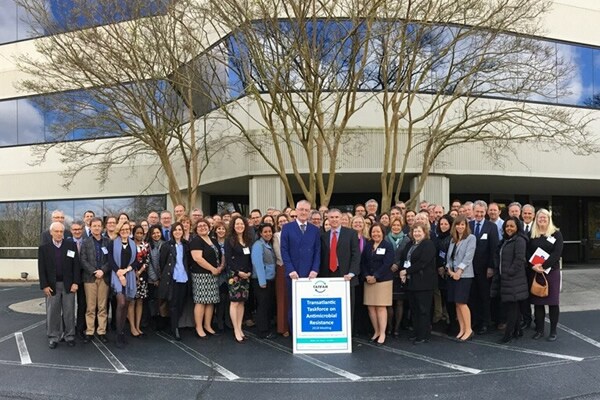Breaking Down the Silos: Addressing AMR with a United Front
Posted On: March 8, 2018

TATFAR provides a unique opportunity for the increased exchange of scientific information at these in-person meetings and throughout the year.
Today we continued the 2018 TATFAR meeting with engaging panel sessions on antimicrobial resistance (AMR), and then went into additional detail during breakout sessions to discuss current TATFAR work and the next two years of implementation. This face-to-face meeting offers a unique opportunity for leading AMR expertsfrom both sides of the Atlantic to engage with each other, breaking down the silos across topics, countries, and governments.
The day opened with a plenary session devoted to strategies for improving the pipeline of new antimicrobial drugs, one of TATFAR’s three key areas. This session included:
- brief presentations from several initiatives with an interest in stimulation of the development pipeline;
- discussion on how there might be alignment of AMR initiatives; and
- discussion on stimulating antibacterial innovation and novel financing sources with a focus on market entry rewards and pull incentives (this work was previously shared in a TATFAR news story).
The morning continued with one final session dedicated to translating surveillance data from point prevalence surveys into action, featuring presentations by TATFAR partners from Canada, the European Union, Norway, and the United States.
In the afternoon, attendees gathered for breakout sessions, guided by TATFAR actions, to develop work plans for the second half of TATFAR’s current implementation period. There was a strong focus on the following actions:
- Action 1.1 – Guidance for assessing appropriate antibiotic use;
- Actions 1.5 and 1.7 – Next generation sequencing and harmonization of data;
- Action 2.1 – Consultation and collaboration on point-prevalence surveys;
- Action 2.5 – How to detect and respond to emerging resistance;
- Action 3.3 – Research to improve the pipeline of antibacterial drugs for human medicine; and
- Action 3.7 – Alternatives to antimicrobials in veterinary medicine.
The meeting’s panel and breakout sessions create opportunities to break down barriers by bringing scientific experts with various backgrounds together to approach AMR with comprehensive, One Health solutions. Additionally, TATFAR facilitates the development of these relationships, which have resulted in several successes to date, such as:
- created unique opportunities for scientific groups to discuss the development of new diagnostic tests and coordination of similar clinical trials;
- supported drug development programs collaboratively to meet European Union and United States regulatory requirements;
- reviewed antibiotic reduction goals in human medicine from TATFAR partner countries, and drafted a summary for publication in a peer-reviewed journal; and
- published papers summarizing economic incentives for antibacterial drug development.
These peer-to-peer relationships will continue beyond the meeting to facilitate progress addressing AMR, including implementation of actions against AMR. In addition, the relationships and collaborations gained through TATFAR better allow its technical experts to support global action on AMR including the Global Health Security Agenda and the World Health Organization’s Global Action Plan on Antimicrobial Resistance.
Follow along on social media with #TATFAR. For more information about TATFAR, email TATFAR@cdc.gov.